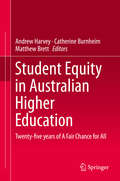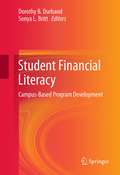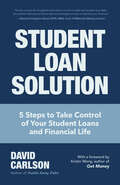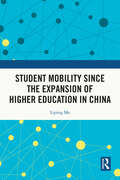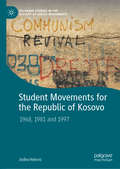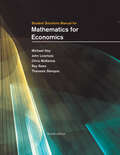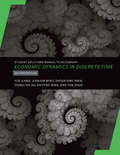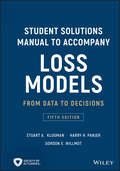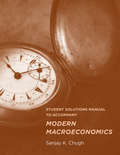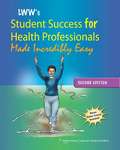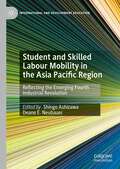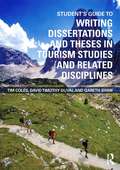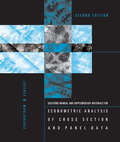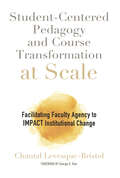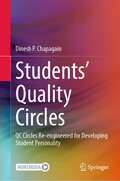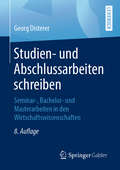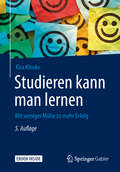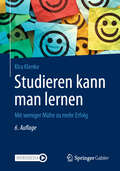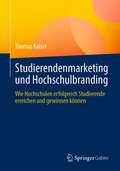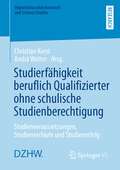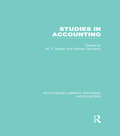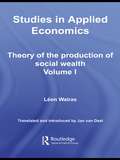- Table View
- List View
Student Equity in Australian Higher Education
by Andrew Harvey Catherine Burnheim Matthew BrettThis book examines twenty-five years of the Australian framework for student equity in higher education, A Fair Chance for All. Divided into two sections, the book reflects on the legacy of equity policy in higher education, the effectiveness of current approaches, and the likely challenges facing future policymakers. The first section explores the creation of the framework, including the major elements of the policy, the political context of its development, and how it compares with international models developed during the same period. The performance of the six student equity groups identified within the framework is also examined. The second section of the book considers future trends and challenges. The Australian university sector has undergone seismic change in the past twenty-five years and faces further changes of equal magnitude. The twenty-fifth anniversary of A Fair Chance for All comes as Australian higher education is poised for another wave of transformation, with rising expansion, competition, and stratification. While the emerging landscape is new, the questions have changed little since A Fair Chance for All was first conceived: How should we define student equity, and what policies are likely to promote it?
Student Financial Literacy
by Sonya L. Britt Dorothy B. DurbandCollege students are particularly vulnerable to making poor financial decisions. One method of addressing personal finances and financial stress among students of higher education is through university based financial education programs. Student Financial Literacy: Program Development presents effective strategies to assist in the implementation or the enhancement of a program as a tool to improve students' educational experience and financial well-being. It presents the key components of financial education programs designed to address the growing concerns associated with high levels of debt and low levels of financial literacy among college students.
Student Loan Solution: 5 Steps to Take Control of Your Student Loans and Financial Life
by David CarlsonEliminate Your Student Loan DebtStep-by-step approach to financial freedom: David Carlson is the author of the book Hustle Away Debt and founder of the millennial personal finance blog Young Adult Money. In Student Loan Solution David explains what student loan borrowers should be focusing on. He provides a 5-step approach to help you understand your loans, your options, and how to improve your greater financial life, while paying down your student loan debt. Learn how to take advantage of strategies that help you make more money, save more money, and ultimately pay down your student loans faster.Everything you need to know about student loan debt: Student loans are complicated. College financial aid terms like “federal direct subsidized” and “GRAD Plus” mean little to most of us. Each type of student loan is slightly different, with its own set of rules and repayment options. Student Loan Solution explains everything you need to know about your student loans including how they work, repayment options and opportunities for loan forgiveness, and plans for managing and paying down your loans. David Carlson covers it all.De-complicate your life: By the time you are done reading this book, you will understand student loans, gain control of your finances, and be armed with strategies to improve your finances.Don't be a statistic: For millions of Americans, paying for college meant taking out loans. If you are one of the 70% of college graduates burdened with these loans, Student Loan Solution could change your life. Fight the student loans epidemic affecting 40 million borrowers?learn the best way to pay off the college degree you worked so hard to earn.Student Loan Solution has the tools you need to start your student loans repayment with a bang. Learn how to:Pay off your student loan debtPersonalize your student loan repayment planLive a happier, financially smarter life
Student Mobility Since the Expansion of Higher Education in China
by Liping MaThis book examines the characteristics of Chinese college students' mobility since the expansion of higher education by using a nationally representative data set. It analyzes college graduates' mobility from both horizontal and vertical dimensions. The horizontal dimension shows college students' migration directions and location changes, including migration for college, migration for employment, migration for grassroots positions, migration away from the capital, and migration back to their hometown. The vertical dimension includes students' intergenerational occupational mobility and intergenerational regional mobility. Drawing on theories of education and economics, the book provides a solid framework for empirically analyzing the characteristics, causes, and economic and non-economic benefits of different forms of mobility. This book not only offers insights into China's higher education policies and their impact on the regional and intergenerational mobility decisions of college graduates over the past two decades, but also has important implications for countries at similar stages of social and economic development. This book is an excellent read for students and scholars of education, economics, and East Asian studies. It can also help policymakers understand the characteristics of students' mobility and the underlying reasons for their choices, so that they can propose effective policies in the future.
Student Movements for the Republic of Kosovo: 1968, 1981 and 1997 (Palgrave Studies in the History of Social Movements)
by Atdhe HetemiThis book analyzes the central vision of three student movements organized by different generations of Kosovo Albanian students in 1968, 1981 and 1997. By examining the dynamics of the demonstrations, the author explores the dimensions, forms and implications of student uprisings and resistance, as well as the struggles for dominance by local (Kosovo), federal (SFRY), regional (Albania and Serbia) and international actors (outside the Balkans). While these demonstrations were organized by students, the book shows that these were not necessarily academic but political, highlighting the impact that students had on society to demonstrate. It examines how the vision for “Republic” status or independence impacted the first and subsequent student movements. Moreover, due to the richness of the empirical data included, this book contributes toward further discussions on social movements, nationalism and state theories.
Student Solutions Manual for Mathematics for Economics, fourth edition
by Thanasis Stengos Michael Hoy John Livernois Chris Mckenna Ray ReesThis student solutions manual contains solutions to odd-numbered exercises in the fourth edition of Mathematics for Economics.
Student Solutions Manual to Accompany Economic Dynamics in Discrete Time, second edition
by Jianjun Miao Yue Jiang Zhouxiang Shen Dongling Su Zhiteng ZengSolutions to the odd-numbered exercises in the second edition of Economic Dynamics in Discrete Time.This manual includes solutions to the odd-numbered exercises in the second edition of Economic Dynamics in Discrete Time. Some exercises are purely analytical, while others require numerical methods. Computer codes are provided for most problems. Many exercises ask the reader to apply the methods learned in a chapter to solve related problems, but some exercises ask the reader to complete missing steps in the proof of a theorem or in the solution of an example in the book.
Student Solutions Manual to Accompany Loss Models: From Data to Decisions (Wiley Series in Probability and Statistics)
by Harry H. Panjer Stuart A. Klugman Gordon E. WillmotLoss Models: From Data to Decisions, Fifth Edition continues to supply actuaries with a practical approach to the key concepts and techniques needed on the job. With updated material and extensive examples, the book successfully provides the essential methods for using available data to construct models for the frequency and severity of future adverse outcomes. The book continues to equip readers with the tools needed for the construction and analysis of mathematical models that describe the process by which funds flow into and out of an insurance system. Focusing on the loss process, the authors explore key quantitative techniques including random variables, basic distributional quantities, and the recursive method, and discuss techniques for classifying and creating distributions. Parametric, non-parametric, and Bayesian estimation methods are thoroughly covered along with advice for choosing an appropriate model. Throughout the book, numerous examples showcase the real-world applications of the presented concepts, with an emphasis on calculations and spreadsheet implementation. Loss Models: From Data to Decisions, Fifth Edition is an indispensable resource for students and aspiring actuaries who are preparing to take the SOA and CAS examinations. The book is also a valuable reference for professional actuaries, actuarial students, and anyone who works with loss and risk models.
Student Solutions Manual to Accompany Modern Macroeconomics
by Sanjay K. ChughSolutions to odd-numbered problem set questions in Modern Macroeconomics.Solutions to odd-numbered problem set questions in Modern Macroeconomics.
Student Success For Health Professionals
by Lippincott Williams Wilkins Staff Nancy OlrechThis Second Edition of Lippincott Williams & Wilkins' Student Success for Health Professionals Made Incredibly Easy has been revised and updated with a more user-friendly organization and design, but retains the health professions focus, the concise and approachable narrative, the fun features and art, and the self-paced online course of the first edition. It is still the first and only student success text designed specifically for health professions students and programs!
Student Success at Georgia State University (A)
by Michael W. Toffel Julia Kelley Robin MendelsonGeorgia State University had developed a reputation for driving student success by nearly doubling its graduation rate for students of all racial, ethnic, and socioeconomic backgrounds. It did so while growing its student body and the proportion of Black/African American, low-income, and first-generation students-groups with historically lower postsecondary graduation rates compared to national averages. Georgia State's Student Success team, led by Tim Renick and Allison Calhoun-Brown, used a data-based approach to deploy micro-grant programs to retain students, implemented predictive analytics to improve student advising, and optimized course sequencing to help students graduate before they exhausted their financial aid. In 2016, they faced a growing "summer melt" problem where nearly 20% of incoming students who committed to attend never actually enrolled at Georgia State-and many never enrolled at any college. At the same time, they wondered how to balance continuing to incrementally improve student success at Georgia State and scaling their efforts to help the many other universities facing similar problems who sought to learn from their experience.
Student Success at Georgia State University (B)
by Michael W. Toffel Julia Kelley Robin MendelsonThis is a supplement to the Student Success at Georgia State University (A) case. The (B) case includes the results of a randomized control trial that Georgia State conducted to test education technology start-up AdmitHub's chatbot solution as a strategy for improving "summer melt" (i.e., applicants confirming that they planned to enroll but then not enrolling).
Student Workbook: Your Route to Success
by John A. Wanat E. Weston Pfeiffer Richard Van GulikDesigned to help students review content, apply knowledge, and develop critical-thinking skills. A wide variety of activities are provided for various learning styles. This supplement is a consumable resource, designed with perforated pages so that a given chapter can be removed and turned in for grading or checking. This Student Workbook is designed for use with the text Learning for Earning: Your Route to Success
Student and Skilled Labour Mobility in the Asia Pacific Region: Reflecting the Emerging Fourth Industrial Revolution (International and Development Education)
by Deane E. Neubauer Shingo AshizawaThis volume explores the implications of student mobility on higher education across the Asia Pacific Region. Student Mobility has become a major feature of higher education throughout the world, and most particularly over the past two decades within the Asia Pacific Region. This system of mobility is entering a period of profound predicted change, created by the social and economic transformations being occasioned by the rapid increased uses of artificial intelligence (AI), a process that is being increasingly framed as the “Fourth Industrial Revolution” or Work 4.0, a process that is widely predicted to evoke fundamental changes in the ways that work is performed and who does it. This volume explores various dimensions of this process, examining various aspects of the process as they are affecting national and regional economies even as the phenomenon produces a wide variety of engagements with the global economy as a whole.
Student's Guide to Writing Dissertations and Theses in Tourism Studies and Related Disciplines
by David Timothy Duval Gareth Shaw Tim ColesAround the world every year very many students have to complete dissertations or theses as part of their undergraduate or masters studies in tourism and related subjects. Often this substantial piece of self-directed work is the culmination of their programmes. More than just a means to consolidate their final grades, it is also an exciting chance to research a topic of their choosing and a potential gateway to more advanced study as well as job offers and future career paths. Yet for all these reasons, many students view the dissertation as a tricky challenge. This comprehensive book intends to take the stress and anxiety out of doing a dissertation in tourism studies and related disciplines. The process is examined from the germination of an idea to the submission and assessment of the final document. Written primarily for students conducting independent research for the first time, this book offers simple advice and a clear framework which students can adopt even in more advanced studies at masters and doctoral level. This book debunks popular myths, and aims to overcome common pitfalls. It focuses on the aims and objectives as the DNA of every dissertation. Rather than view it as a single, overwhelming project, the dissertation is presented as a series of more modest, manageable yet crucially inter-linked tasks that all students can successfully complete through careful preparation and effective time management. Dissertations are not to be underestimated and they demand great care and attention, but they can also be immensely rewarding and enriching experiences academically and personally. This ‘jargon free’ book is also written with overseas students specifically in mind, drawing directly on our overseas students’ experiences. This valuable resource contains start of chapter learning objectives and end of chapter checklists, as well as numerous boxed case studies, to further help assist students through their dissertation.
Student's Solutions Manual and Supplementary Materials for Econometric Analysis of Cross Section and Panel Data, second edition (The\mit Press Ser.)
by Jeffrey M. WooldridgeThis is the essential companion to the second edition of Jeffrey Wooldridge's widely used graduate econometrics text. The text provides an intuitive but rigorous treatment of two state-of-the-art methods used in contemporary microeconomic research. The numerous end-of-chapter exercises are an important component of the book, encouraging the student to use and extend the analytic methods presented in the book. This manual contains advice for answering selected problems, new examples, and supplementary materials designed by the author, which work together to enhance the benefits of the text. Users of the textbook will find the manual a necessary adjunct to the book.
Student-Centered Pedagogy and Course Transformation at Scale: Facilitating Faculty Agency to IMPACT Institutional Change
by Chantal Levesque-BristolIn response to national concerns a decade ago, driven by research that showed that higher education was making little impact on students’ development of broad competencies and critical thinking, the provost and president of Purdue University, a research university, instituted a program whose goals were to build on the accumulated knowledge on effective teaching to facilitate student learning, improve outcomes, and change the institutional culture around teaching and learning – objectives to which many institutions aspire, but which few consistently attain, or attain at scale.This book describes the development of Purdue’s IMPACT program (Instruction Matters: Purdue Academic Course Transformation), from its tentative beginning, when it struggled to recruit 35 faculty fellows, to the present, when 350 have been enrolled and the university has more applications than it can currently handle. Overall, more than 600 courses have been impacted, many of which have seen significantly reduced DFW rates. Chantal Levesque-Bristol, whose Center for Instructional Excellence is part of an institutional team that comprises the Provost’s Office, Teaching and Learning Technologies Unit, Institutional Assessment, the Purdue University Library and School of Information Studies, and the Evaluation and Learning Research Center, describes the evolution of IMPACT, lessons learned, and the central tenets that have led to its success. The purpose of this book is notonly to describe the program, but also to highlight the importance and implications of the underlying motivational theoretical framework guiding the initiative. Having started as a course redesign program that faltered in achieving its objectives, the breakthrough came with the introduction of the fundamental motivational principles of self determination theory (SDT) followed by the applications of these principles to the research in higher education leadership and pedagogy. Giving faculty fellows the autonomy to build on their disciplinary expertise, pursue their interests and predilections, within a guided framework, and leveraging interactions with colleagues through FLCs, stimulated faculty fellows’ motivation and creativity.This book describes the core and structure of the IMPACT program, presents details of faculty learning curriculum, explains how the focus on SDT principles shaped the program’s evolution and transformation from a course redesign to a professional faculty development program, and covers the considerations behind the formation of faculty fellow IMPACT teams A concluding chapter addresses how the IMPACT program, having helped faculty pivot to emergency remote teaching when the campus closed owing to the COVID-19 pandemic, is being modified so it can be successfully sustained online if circumstances require, or as a means to expand its reach in the future.While the principles behind this initiative will be of compelling interest to its primary audience of faculty developers, several chapters will have appeal to instructors and administrators.
Students’ Quality Circles: QC Circles Re-engineered for Developing Student Personality
by Dinesh P. ChapagainThis book explains what Students' Quality Circles (SQC) are, how they function, key constraints and issues in implementation, and possible solutions to make it a valuable co-curricular activity. It showcases how Quality Control Circle (QCC) is reengineered with the sole purpose of prosocial personality development of students at their early age. It is a research outcome which depicts the direction of the education system toward character building rather than only developing knowledge and skills. The logical sequence of presentation of the book is ‘why,’ ‘what,’ and toward the end, ‘how’ SQC in education. The book satisfies four hierarchical levels of readers. The first level is of educationists and national policy makers who may take up SQC as an important approach of the education system in their country for prosocial personality development of students and thereby targeting to produce quality citizens in the future. At the second level are chief executives or managers of educational institutes who may identify the potential of SQC approach for developing the positive personality of their students. Teachers and SQC facilitators are at the third level, and they can use the book to train and educate their students while initiating and promoting SQC activities at their institutes. And finally, at the fourth level obviously are students who may refer to this book from time to time and practice SQC on their own for self-development and empowerment.
Studien- und Abschlussarbeiten schreiben: Seminar-, Bachelor- und Masterarbeiten in den Wirtschaftswissenschaften (Springer-Lehrbuch)
by Georg DistererDieses Buch hilft Studierenden der Wirtschafts- und Sozialwissenschaften, Studienarbeiten aller Art erfolgreich zu schreiben, also etwa Hausarbeiten und Seminararbeiten sowie Abschlussarbeiten wie Bachelorarbeiten und Masterarbeiten. Detailliert werden die inhaltlichen und formalen Anforderungen an Studienarbeiten beschrieben und die Gründe für formale Regularien in Prüfungsordnungen und Zitierrichtlinien erläutert. Das Buch bietet einen anschaulichen Leitfaden und gibt konkrete Unterstützung in einer prägnanten und verständlichen Darstellung. Die Anforderungen an Studienarbeiten werden auf diese Weise transparent und klar. Durch die im Buch enthaltenen anschaulichen und nützlichen Handlungsanleitungen wird das Anfertigen von Studienarbeiten zu einer interessanten und spannenden Aufgabe.
Studieren kann man lernen: Mit Weniger Mühe Zu Mehr Erfolg
by Kira KlenkeSie möchten den Lernstoff schneller verstehen und besser für die Prüfung behalten? – Dieses Buch präsentiert Ihnen ein praxiserprobtes Selbstcoaching-System, das Sie zuverlässig durchs Studium navigiert. Die Autorin enttarnt gängige Lernmythen und vermittelt Motivationshilfen, Lerntechniken und mentale Tricks, die Sie an der Uni so nicht lernen. Sie zeigt Ihnen, wie Sie sich kraftvoller fühlen, zuversichtlicher und selbstbewusster studieren, Stress und Prüfungsangst reduzieren, effektiver arbeiten und bessere Noten erreichen. Rückmeldungen von Leserinnen und Lesern belegen dies vielfach.Jedes Kapitel startet mit übersichtlichen Lernzielen und endet mit praktischen Tipps für Ihren Studienalltag. Die aktuelle fünfte Auflage erscheint neu mit eBook inside, um Ihren persönlichen Fortschritt auf allen Ebenen noch besser zu unterstützen.
Studieren kann man lernen: Mit weniger Mühe zu mehr Erfolg
by Kira KlenkeLeichter, selbstbewusster und stressfreier lernen mit deutlich besseren NotenSind Sie lustlos und unmotiviert in Ihrem Studium? Oder gehören Sie zu den Arbeitstieren, die unter der Workload vergessen zu leben?Dieser Ratgeber entlarvt irreführende Lernmythen und vermittelt Motivationshilfen, Lerntechniken und mentale Tricks, die Sie so an der Uni nicht lernen. In jedem Kapitel finden Sie auf einen Blick eine Übersicht der Lernziele am Anfang und eine Checkliste mit Tipps für die praktische Umsetzung am Ende.Erfahren Sie, wie Sie• leichter lernen als bisher, motiviert und effektiv,• Glaubenssätze, die Ihr Lernen behindern, aufdecken und upgraden,• Selbstzweifel und Ängste überwinden,• sich motivierend kraftvolle Ziele fürs Studium setzen - und sie auch erreichen,• Schreibhemmungen überwinden und mühelos gute Texte verfassen.Nach dem Erfolg der früheren fünf Auflagen wurde die aktuelle, überarbeitete sechste Auflagedurch Lern-Meditationen ergänzt, abrufbar mit der App SN More Media. Diese Audios führen Sie schnell in einen entspannten Zustand, in dem das Gedankenkarussell im Kopf zur Ruhe kommt, und helfen Ihnen, selbstbewusst, motiviert und leichter zu studieren.
Studierendenmarketing und Hochschulbranding: Wie Hochschulen erfolgreich Studierende erreichen und gewinnen können
by Thomas KaiserDieses Buch zeigt, mit welchen Methoden, Strategien und Maßnahmen Hochschulen nachhaltig und effizient Studierende gewinnen. Alle Möglichkeiten entlang der Student Journey werden detailliert beleuchtet: Planung und Steuerung von Online-Marketing-Kampagnen, Zielgruppen-Analyse, Optimierung der Website, benutzerfreundlicher Bewerbungsprozess, Positionierung und Internationalisierung bis zur Erzielung von Bewertungen und Rankings.Hochschulen spüren die rückläufige Zahl an Erstimmatrikulierten. Ein erfolgreiches Studierendenmarketing wird immer wichtiger, auch international. Der Weg von der Zielgruppen-Ansprache bis zu konkreten Bewerbungen enthält aber viele Hürden und Fallstricke. Mit praxisnahen Beispielen, Best-Practice-Ansätzen und Handlungsempfehlungen können sich Hochschulen erfolgreich in der sich wandelnden Hochschullandschaft positionieren und mehr Bewerbungen erzielen. Der Autor bietet Lösungen für die Bedürfnisse und Fragen der Zielgruppe, zeigt die Wirksamkeit für verschiedene Kanäle auf und bezieht sich dabei immer auf die jeweilige Phase der Student Journey. Mit zusätzlichem Arbeitsmaterial zum Herunterladen
Studierfähigkeit beruflich Qualifizierter ohne schulische Studienberechtigung: Studienvoraussetzungen, Studienverläufe und Studienerfolg (Higher Education Research and Science Studies)
by Christian Kerst Andrä WolterDer Band berichtet über empirische Forschungsergebnisse aus einer Längsschnittuntersuchung zu den Studienvoraussetzungen, zum Studienverlauf und Studienerfolg von beruflich Qualifizierten. Im Zentrum stehen solche Personen, die nicht über eine schulisch erworbene Studienberechtigung in die Hochschule gekommen sind. Das Kernergebnis besteht darin, dass diese Studierendengruppe ähnlich erfolgreich studiert wie andere Studierendengruppen auch.
Studies in Accounting (Routledge Library Editions: Accounting)
by W. T. Baxter Sidney DavidsonThis volume brings together noteworthy articles in accounting. Some of the pieces existed in journals, but many were commissioned specifically for this volume. They fill gaps in the usual text-books, gaps that are particularly glaring where concepts are at issue. Among other things the articles cover: depreciation dividend law social accounting value and income inflation
Studies in Applied Economics
by Léon WalrasFirst Published in 2004. Routledge is an imprint of Taylor & Francis, an informa company.
